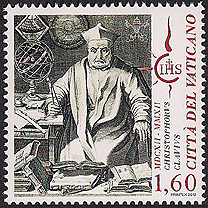
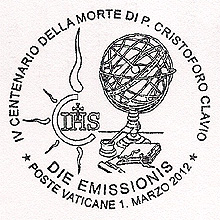
VATICAN CITY, 2012, to celebrate the 4th centenary of Clavius' death, and its FDI cancel, Scott 1494
Father
Christopher Clavius, SJ |


VATICAN CITY, 2012, to celebrate the 4th centenary of Clavius' death,
and its FDI cancel, Scott 1494

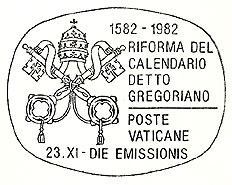

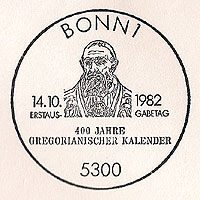
VATICAN CITY, 1982, the 4th centenary of the Gregorian calendar, Scott
716
from a souvenir sheet (see below) and its FDI cancel
GERMANY, 1982, the 4th centenary of the Gregorian calendar, Scott 1383,
and its FDI cancel

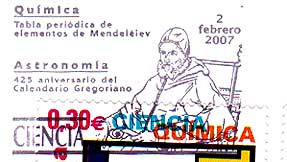
SPAIN, 2007, the 425th anniversary of the Gregorian calendar, Scott 3477 and its FDI cancel
MONTENEGRO, 2007, the 425th anniversary of the Gregorian calendar, Scott 155Clavius was born in Bamberg just before the founding of the Jesuits. He entered the Order at age 17, and studied at Coimbra in Portugal and later at the Roman College, excelling in mathematics and astronomy. Clavius taught mathematics at the Roman College from 1564 until 1612. He published profusely — his writings affected the teaching of mathematics in Jesuit schools all over the world — and was the chief mathematician on the commission that led to the Gregorian reform of the calendar. Christopher Clavius helped create this modification that suppressed the days between October 5 and 15 in order to bring the calendar into line with astronomical facts. That was the historical night on which St. Teresa of Avila died. Countries that did not like the Pope liked his calendar even less, so it was not until the 20th century that all countries adopted it as their civil calendar. Pope Sixtus V said, "Had the Jesuit Order produced nothing more than this Clavius, on this account alone the Order should be praised."
The image on the Vatican stamp is from the tomb of Pope Gregory XIII in St. Peter's Basilica. The tomb, the work of Camillo Rusconi, includes a relief showing Clavius kneeling before the Pope, presenting his work as the Pope promulgates the new calendar in 1582.
The souvenir sheet of the above stamp, Scott 717a